Amazon’s Robotics Fleet Grows: Latest Robot Uses AI to Sort Items – Innovation & Tech Today

A new Amazon warehouse robot uses AI and computer vision to recognize and delicately pick up millions of items in its inventory. Like its predecessors, Cardinal and Robin, the Sparrow robot is part of Amazon’s picker technology lineup, little more than a mechanical arm that grabs products at will. However, it’s unique in that it can recognize individual objects.
How Amazon’s Robot Uses AI
Mechanical arms are nothing new. Factories have been using them since 1961 when the Unimate 1900 robotic arm performed metalworking and welding on the General Motors assembly line. Since then, these robotics have been the darlings of repetitive factory jobs, able to perform the same motion tirelessly thousands of times per day. However, they don’t have eyes.
Unlike the robots that grasp blindly at the same type of objects placed in the same spot every time, Sparrow can see — if you can extend that term to an automaton. The ironically named robot is not delicate and brown like its namesake but rather large and imposing, shaped like a bright, industrial yellow streetlight with a tangle of blue cords bursting from its joints.
The robot is equipped with sensors that detect size, shape, and barcodes, using AI and computer vision to recognize the products it’s moving. It then uses suction-cup-tipped fingers to place them in the correct bins.
Well, mostly, anyway. It isn’t perfect, but it can detect around 65% of Amazon’s inventory. Considering Amazon sells everything from live crickets to raffle tickets, all with slight variations depending on the brand, this is an impressive feat.
It’s even more remarkable when you realize there are many Amazon products Sparrow never encounters, like mattresses and granite benches, which means the 65% accuracy statistic is misleadingly low. Sparrow is smart. It was introduced in November 2022 and is a sure sign of what’s to come in the shipping industry.
Amazon’s Automatons
Amazon acquired Kiva Systems Inc., a tech company specializing in warehouse robots, in 2012. A decade later, Amazon has finally rolled out several types of automatic robots in its fulfillment centers.
The first one, named “Proteus” after the shapeshifting Greek god of the sea — or perhaps the bacteria, which it more closely resembles — looks like the flattened lovechild of a Roomba and a forklift. It has one job: lifting and transporting large stacks of boxes. It may not shapeshift, but it does extend and flatten to work its way under the giant metal containers it has to lift overhead. Perhaps Atlas would have been a better name.
Like a Roomba vacuum, Proteus uses a front-facing sensor to detect objects in its path. This helps it avoid the constant traffic flow of people and other robots while gravitating toward the items it needs to move.
Another robot that populates the fulfillment center is Cardinal. Like Sparrow, it’s a mechanical arm with AI and computer vision, but it can’t recognize individual items. Instead, it picks up already-packaged boxes and reads their labels. This allows it to sort them into the proper bins for shipping.
Robin does a similar job of sorting packages for shipping, using its scanner to read ZIP codes and placing boxes in the correct location. It can also identify damaged packages. If it sees any holes or tears in the parcel, or if it has an illegible address, Robin sends it back for employees to take care of.
What Automation Means for Workers
Amazon has always wanted to automate its warehouses. Faced with public criticism about poor employee working conditions — such as overheated buildings with no air conditioning, impossibly large quotas to fill, and constant heavy lifting leading to injuries — the order fulfillment giant says automation will benefit its employees.
Sparrow works alongside workers yet it could replace certain human jobs if used on a larger scale. Amazon currently has hundreds of thousands of people sorting, picking, and packing items in its fulfillment centers, but that could change with the introduction of robots that use AI. Picker robots and automated guided vehicles (AVGs) could also make up for labor shortages by transporting products throughout warehouses.
There are numerous benefits of automating warehouse jobs. Some of them include:
Of course, many people are quick to point out the downsides of incorporating robotics in a warehouse setting. Some potential negatives include:
Amazon might have to change the layout and design of its warehouses, which currently use mesh shelves to hold products, to integrate Sparrow and other robots into its warehouses. This type of shelving is likely incompatible with robotic arms. However, as the second wealthiest company in the world by consolidated revenue, Amazon can probably handle that.
The Future of Automation
Amazon’s new warehouse robot uses AI to streamline the order fulfillment process, deftly sorting items into bins based on their size, shape, and barcode. It’s not the first mechanical arm on the scene, but it’s certainly unique for Amazon due to its ability to recognize objects. Sparrow is likely a sign that, before long, AI and computer vision will be ubiquitous in factories.
Emily Newton is a tech journalist. As Editor-in-Chief of Revolutionized, she regularly covers science and technology stories. Subscribe to Innovation & Tech Today to read more from Emily.
